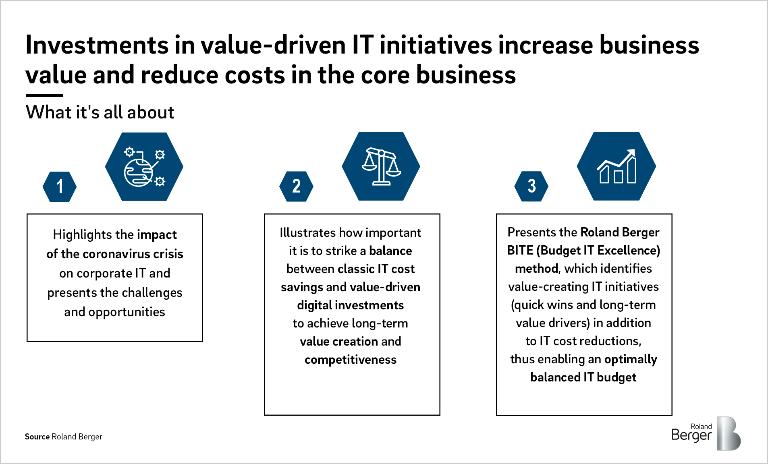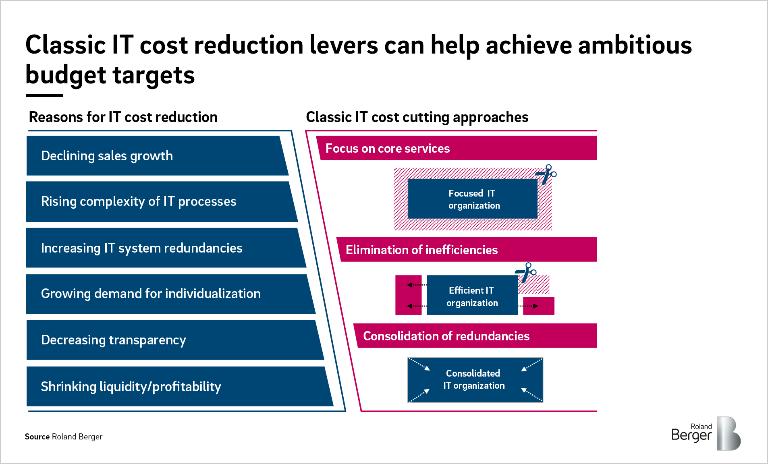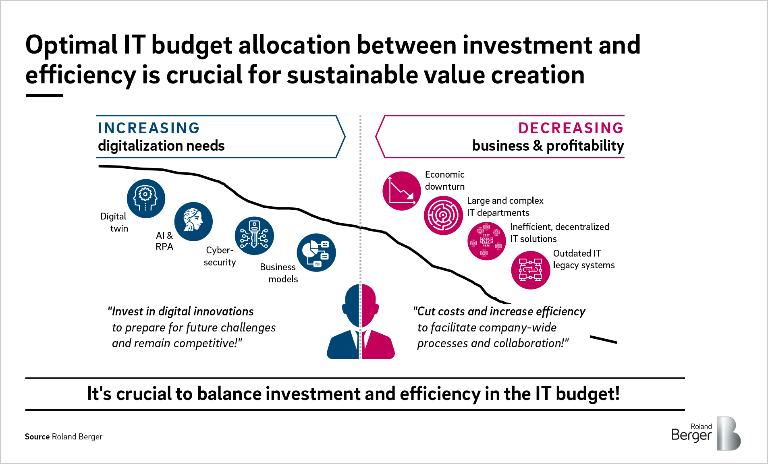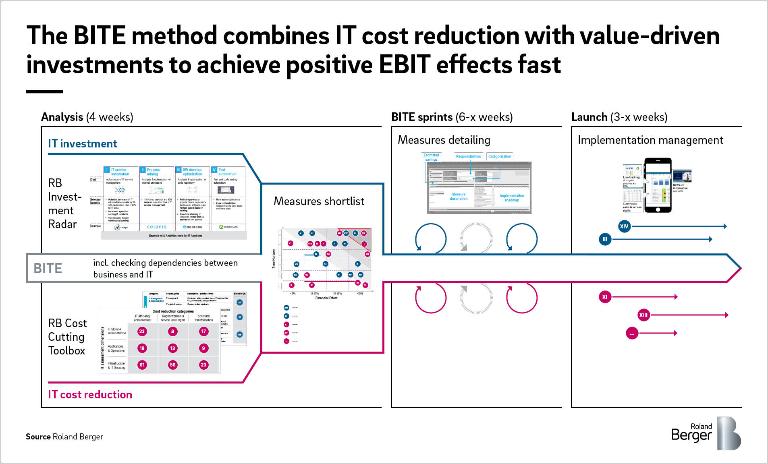

IT budgets in a dilemma
A balancing act between IT cost savings and value-oriented investments
By Carsten Rossbach , Frederik Hammermeister and Dirk Moebus
The coronavirus pandemic and the accompanying downturn in the global economy are draining the liquidity pool available to organizations. Controlling costs will be the difference between survival and bankruptcy. Yet indiscriminately taking the axe to IT costs will diminish your company's competitiveness long term. Today, it's more important than ever to strike a balance between reducing costs in IT and making value-driven digital investments, i.e. spending that has a positive impact on cash flow or EBIT.
To help companies pull off this precarious balancing act between adding value and cutting costs, Roland Berger offers BITE (Budget IT Excellence), a proven method that identifies value-adding investments in digital technologies alongside targeted cost savings in IT. Targeted is the operative word, because blanket IT cost cutting just leads to technical debt as well as competitive disadvantages in an increasingly digital economy. This was already a common mistake in pre-coronavirus times. For the future it is all the more important to find the right balance.
The coronavirus crisis is first and foremost a human tragedy, but it also has serious consequences for the global economy: restrictions on contact, interrupted supply chains and plant closures are piling the pressure on companies to increase revenues and reduce costs. Not for the first time, the importance of targeted cost control as a means for organizations to optimally balance their budgets is becoming apparent. And it's particularly evident in IT. Today's IT organizations face the Herculean task of driving cost reduction programs while simultaneously digitalizing business processes .
1. Challenges, opportunities and business implications
Over the last decade of steady growth, IT organizations have increased in size and influence. Once considered a mere support function, IT has evolved into a core function for many companies around the world as they seek to push digitalization into every corner of their business. Substantial investments in digitalization, and thus in IT, have been essential for firms to become – or remain – competitive.
That said, whenever order books face sharp contractions, the focus tends to rest firmly on a company's liquidity and profitability needs, so IT budgets are currently coming under heightened pressure:
- In response to the global coronavirus outbreak, almost all companies took immediate measures to secure their liquidity. By mid-April 2020 alone, around 30% of all digital projects in Germany had been cancelled or indefinitely put on ice.
- The IT consulting and market research company Gartner has significantly corrected its forecast for IT spending from 3.9 to 3.4 trillion dollars. All areas are affected, from data centers to IT services and equipment.
Despite the heightened cost pressure, the coronavirus crisis underlines how indispensable digital tools and workplaces are today – in many places it's not less but more investment in digital technologies that's needed. Indeed:
Indiscriminate measures to reduce costs and increase efficiency must not prevent IT departments from continuing to contribute to their organization's value creation:
- Headcount reductions must not impair the quality of critical IT services
- Cost reductions must be balanced against the value that IT contributes
- Necessary investments must be distinguished from unnecessary spending
- Standardization and restriction of basic services must not jeopardize the core needs of the operational business
- Termination of any IT projects must not endanger the provision of services
- IT cost reductions must not lead to higher process costs on the user side
IT therefore has to walk the tightrope between cost savings and digital spending in order to realize efficiencies and adapt to the current conditions. Companies' ability to master this balancing act between cutting IT costs to ensure survival and making crucial investments in adequate digital technologies is what will distinguish the winners of this crisis from the losers.
Project example 1 – Project management professionalization: In spite of the coronavirus crisis and ongoing corporate restructuring, an automotive supplier invested some EUR 1.4 million in a project management system to digitalize workflows, increase the transparency of project costs/earnings and ensure comprehensive resource planning. The result? Efficiency potential of up to 15% was identified in the operational business as well as in project management and product development.
The efficiency problem needs to be viewed through the lense of value creation. When budgets are tight, IT must itself make a contribution to the cost savings and put its own use of resources under the microscope. At the same time, it must help the company invest in the right IT initiatives that can keep costs permanently down in the core business and increase competitiveness long term. This could be through:
- Automation and digitalization of business processes
- Use of technologies to standardize processes and reduce redundancies in the core business
- Targeted use of modern analytics solutions
Project example 2 – Process improvement with ERP: A comparison of IT at two companies (A and B) indicated that IT costs were higher at B. However, a detailed analysis revealed that at B, invoice verification processes were much better supported by a good ERP system and therefore considerably fewer FTEs were required for the same volume of procurement – a blanket reduction of IT spend at company B would therefore be extremely counterproductive.
When trying to identify the right investments, both quick wins and measures that will drive value medium to long term, it's essential to have not only an analytical view of the core business but also a trained eye for potential in IT – along with the ability to make this transparent to the business.
Project example 3 – Pragmatic design of the IT system: Instead of migrating the whole of procurement over to the next ERP generation, the decision was made to pragmatically introduce a P2P platform for operational processes and interfaces to the diverse ERP landscapes across the individual countries. The necessary transparency is achieved through BI reporting based on the normal data warehouse.
What this requires is a holistic view of processes and systems alike. Simple as it may sound, this is actually quite challenging to achieve in practice because it's often the case that IT and business don't speak the same language. It can be helpful to take a structured approach.
Project example 4 – Investment in IT automation: The use of cross-domain tools in infrastructure and application operations facilitates greater transparency for our client, alongside faster response times and a higher degree of automation. Payback is achieved in two years.
In summary, it is crucial to maintain a balance between classic IT cost savings in non-business-critical areas and necessary investments in value-adding digital initiatives. In these coronavirus times, getting the balance just right is more important than ever.
2. The BITE approach – fast, effective, individual
A sprint-based method, BITE enables you to optimally balance all areas of the IT budget and ensures fast and sustainable results while identifying potential pitfalls.
The first stage is an analysis phase during which a longlist of classic IT cost reduction measures and value-adding digital initiatives is compiled. This involves:
- Identifying investment opportunities in digital initiatives in an approach that is not limited to IT but spans all business functions. The RB Investment Radar (comprehensive overview of digital solutions such as automation, process mining, software development optimization, etc.) is used as a basis for joint testing with business departments and IT in a workshop setting (IT investment stream)
- Identifying cost reduction opportunities in IT with the use of the RB Cost Cutting Toolbox containing effective cost saving tools. These are customized to the client's situation over a number of workshops/interviews with the IT organization (IT cost reduction stream)
- Early examination of the key dependencies between business and IT, including analysis of the risks of potential cost reduction measures and consideration of the regulatory and legal framework
Once the longlist of IT cost reduction measures and digital investments is in place, the initiatives are evaluated using the BITE scorecard. This takes place in a workshop setting with IT and the business departments, and specifically comprises:
- Evaluating the measures (IT investment & IT cost reduction streams) to identify their EBIT or cash flow effects (e.g. different EBIT effects for process automation vs. introduction of data analytics software)
- Evaluating the measures (IT investment & IT cost reduction streams) to see how long they will take to implement (e.g. different implementation horizons for process digitalization vs. IT system harmonization)
- Additionally evaluating the measures from the IT cost reduction stream to identify their EBIT and cash flow effects where they have business-critical impact (e.g. increased process or opportunity costs in the core business due to termination of individual IT services/processes)
- Prioritizing measures based on their score and drawing up a shortlist of immediate IT cost reduction measures to improve liquidity and medium-term investment measures to keep the business operating competitively
Following thorough analysis and evaluation of the identified cost reduction levers and digital value drivers, the intensive BITE sprints begin. The procedure is as follows:
- Parallel detailing of measures from both workstreams (IT investment & IT cost reduction) in sprints, each normally lasting two weeks
- Detailing the requirements, preparing implementation plans with owners and milestones, validating investment costs and savings potential, as well as developing performance indicators for each measure
- Identifying and implementing pilot projects
Once the BITE sprints have been completed, the implementation phase ensues, when the measures are realized in line with the defined implementation plans.
The result is an evolving portfolio of quick wins to improve liquidity and value-driven initiatives to sustain the company's competitiveness going forward.










